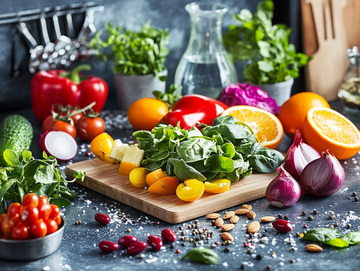Ready-made protein powders from the supermarket often contain artificial additives and cost a fortune. Homemade shakes, on the other hand, give you complete control over ingredients, taste, and nutritional content. In this guide, we share five tried-and-true protein shake recipes, perfect preparation techniques, and the optimal timing for maximum muscle gain.
What ingredients does your perfect muscle-building shake need?
An effective protein shake for muscle building consists of three fundamental building blocks that work synergistically together. This combination distinguishes a true muscle-building drink from low-calorie diet shakes.
Protein component as a foundation
The protein source is the heart of your shake. Animal proteins such as low-fat quark, Greek yogurt, or cottage cheese provide all essential amino acids in an optimal combination. Quark boasts 12-14 grams of protein per 100 grams at only 60-70 calories. Greek yogurt offers an even higher protein content of 15-18 grams and a creamy texture.
Plant-based alternatives such as MTM Vegan Protein cleverly combines various protein sources. Pea and rice protein complement each other perfectly, as they have different amino acid profiles. Individually, they may have weaknesses, but together they achieve biological values of over 100.
Carbohydrates for energy and regeneration
Carbohydrates act as fuel for intense workouts and accelerate recovery. Oatmeal is the gold standard here—it provides long-chain carbohydrates and an additional 13 grams of protein per 100 grams. Bananas provide readily available energy plus potassium for optimal muscle function.
Frozen berries provide anthocyanins, which reduce inflammation and promote recovery. Dates are naturally sweet and contain fiber, which stabilizes blood sugar levels.
Healthy fats for hormone production
Fats are essential for testosterone production—the most important muscle-building hormone. Nuts, almonds, and flaxseeds provide unsaturated fatty acids and additional protein. One tablespoon of almond butter provides 4 grams of protein and 8 grams of healthy fat.
Avocado makes shakes creamy and filling, while MCT oil provides quick energy without insulin release. The fatty acids also support the absorption of fat-soluble vitamins A, D, E, and K.
What equipment do you need for the perfect shake?
The right equipment determines the consistency and taste of your protein shake recipe. Different appliances have specific advantages and disadvantages that you should be aware of.
-
Stand mixer for perfection
High-performance blenders effortlessly crush even the toughest ingredients. Nuts, frozen fruit, or oatmeal are processed into a velvety smooth consistency. The high speed creates air pockets that add volume to the shake. Models with at least 1000 watts of power can easily handle even large quantities.
-
Shaker for on the go
A high-quality The MTM Shaker is perfect for simple mixes without solid ingredients. The sieve prevents clumping and allows for even distribution of all components. It's the first choice for protein powder with liquid. Graduated markings help with precise dosing.
-
Hand blender as a compromise
Hand blenders score points for their flexibility and ease of cleaning. They're ideal for soft ingredients like bananas, berries, or cooked vegetables. Harder ingredients like nuts should be ground first.

Preparation tips for creamy results
Optimal order:
1. Fill the liquid first
2. Add soft fruit and protein sources
3. Solid ingredients such as nuts or oatmeal
4. Frozen components at the end
This sequence prevents ingredients from sticking to the bottom. Start at a low speed and gradually increase. 30-60 seconds of blending time is usually sufficient.
Professional tricks for better results: Frozen bananas make for ice-cold shakes without adding water. Soak oats in liquid for 10 minutes before blending to make them creamier. Warm nut butter to help it spread.
5 Proven Protein Shake Recipes for Maximum Muscle Building
These five protein shake recipe variations cover different taste preferences and each provide 25-35 grams of high-quality protein.
Recipe 1: Classic Berry-Banana Power Shake
Ingredients:
- 200g low-fat curd cheese
- 1 ripe banana
- 100g mixed berries (frozen)
- 200ml milk or almond milk
- 1 tbsp oatmeal
- 1 tsp honey
Nutrients: 380 calories, 32g protein, 45g carbohydrates, 8g fat
The berry's antioxidants reduce training stress, while the banana provides a quick energy boost. Perfect after intense strength training sessions.
Recipe 2: Chocolate Nut Dream
Ingredients:
- 150g Greek yogurt
- 1 banana
- 2 tbsp almond butter
- 1 tbsp cocoa powder (unsweetened)
- 250ml oat milk
- 1 tsp maple syrup
- handful of ice cubes
Nutrients: 420 calories, 28g protein, 38g carbohydrates, 18g fat
Cocoa contains theobromine, which improves blood circulation and optimizes the supply of nutrients to the muscles.
Recipe 3: Green Energy Booster
Ingredients:
- 200g cottage cheese
- 1 handful of spinach
- 1/2 avocado
- 1 green apple
- 300ml coconut water
- Juice of half a lime
- 1 tsp ginger (fresh)
Nutrients: 350 calories, 30g protein, 35g carbohydrates, 12g fat
Spinach provides nitrates for improved oxygen supply to the muscles. Ginger has anti-inflammatory properties.
Recipe 4: Tropical Coconut Mango Shake
Ingredients:
- 180g Skyr
- 150g mango (frozen)
- 2 tbsp desiccated coconut
- 200ml coconut milk
- 1 tbsp chia seeds
- 1 tsp vanilla extract
Nutrients: 390 calories, 35g protein, 32g carbohydrates, 15g fat
Chia seeds swell and provide long-lasting satiety. Coconut provides medium-chain fatty acids for quick energy.
Recipe 5: Hearty Vegetable Protein Shake
Ingredients:
- 200g cottage cheese
- 1/2 cucumber
- 1/4 red bell pepper
- 200ml vegetable broth (cold)
- 1 tbsp flaxseed
- Herbs of your choice (dill, parsley)
- Pinch of salt and pepper
- Nutrients: 280 calories, 28g protein, 15g carbohydrates, 12g fat
This savory version is a nutritious snack and provides you with vitamins and minerals from fresh vegetables.
All recipes are prepared the same way : Add ingredients one at a time to a blender and blend on high for 30-45 seconds. Enjoy immediately or refrigerate for up to 2 hours.
When should you drink your protein shake?
 The timing of your protein shake is crucial to its effectiveness. Unlike low-calorie weight-loss shakes, which focus on meal replacement, muscle-building shakes aim to provide optimal nutrient delivery at strategic times.
The timing of your protein shake is crucial to its effectiveness. Unlike low-calorie weight-loss shakes, which focus on meal replacement, muscle-building shakes aim to provide optimal nutrient delivery at strategic times.
Before bedtime, a casein-rich shake (made with quark or cottage cheese) can promote nighttime muscle protein synthesis. Casein is slowly digested and supplies the muscles with amino acids for 6-8 hours.
Adjustments for different training goals and needs
Every body reacts differently to nutrients. Nutritional recipes must be individually tailored to achieve optimal results.
Vegan and vegetarian optimization
Plant-based protein combinations require a strategic approach. The biological value increases significantly when you cleverly combine different protein sources.
Optimal combinations :
- Pea protein + rice protein (3:1 ratio)
- Oat flakes + nuts for a complete amino acid profile
- Quinoa + almonds as a creamy base
- Hemp seeds + chia seeds for omega-3 fatty acids
MTM Supplements already offers optimized blends that utilize these synergies. Combining individual protein powders can be expensive and impractical.
Hardgainer adaptations
People with fast metabolisms need more calorie-dense shakes. Add healthy calorie boosters:
- Extra virgin olive oil (1 tbsp = 120 calories)
- Nut butter or tahini for creamy texture
- Whole milk instead of water or low-fat milk
- Additional bananas or dates
- MCT oil for fast energy supply
Allergy-friendly variants
Lactose intolerance, nut allergies or gluten intolerance require creative solutions:
- Lactose-free: plant milk, vegan protein powder, coconut yogurt
- Nut-free: Sunflower seeds, pumpkin seeds as a source of fat
- Gluten-free: Quinoa flakes instead of oat flakes, rice protein
- How do you avoid the most common protein shake mishaps?
Use the post-workout window
The first 30-60 minutes after training are considered the anabolic window. Your muscles are particularly receptive to nutrients during this time. A protein shake with readily available carbohydrates and proteins maximizes muscle protein synthesis.
20-25 grams of high-quality protein after training can increase muscle protein synthesis by up to 50%. The right protein source makes all the difference here. Whey protein and cottage cheese are absorbed particularly quickly.
Strategic times of day
In the morning, your glycogen stores are at their lowest. A protein-rich shake with complex carbohydrates kick-starts your metabolism and prevents muscle loss. Cortisol levels are naturally elevated in the morning—protein can counteract this catabolic hormone.
Between meals, protein shakes provide a constant supply of amino acids. They support recovery, especially on non-training days.
Even experienced athletes make mistakes when preparing shakes that can slow down their progress.
1. Too few calories for muscle building
The biggest mistake: confusing it with a protein shake for weight loss. Building muscle requires a calorie surplus of 200-500 calories daily. Shakes with only 150-200 calories aren't enough to build new muscle mass.
Hardgainers even need a 500-800 calorie surplus. A single shake should provide at least 300-400 calories to achieve noticeable results.
2. Unbalanced macronutrient distribution
Protein alone doesn't build muscle. The optimal ratio is 25-30% protein, 45-55% carbohydrates, and 20-25% fat. Pure protein shakes without carbohydrates waste anabolic potential, as insulin is needed for muscle building.
3. Hidden sugar traps
Large amounts of fruit juices, sweetened plant milk, or honey cause blood sugar to spike. While this increase leads to insulin release, it also leads to increased fat storage. Stick to a maximum of 1-2 tablespoons of sweetener per shake.
4. Timing errors when taking the medication
A full shake directly before training can cause nausea. A gap of 60-90 minutes is optimal. After training, the shake should be consumed within 30 minutes to take advantage of the anabolic window.
5. Incorrect storage and hygiene
Homemade shakes will keep for a maximum of 2 hours at room temperature. They can be refrigerated for up to 24 hours. Clean the blender and shaker thoroughly after each use to prevent bacterial growth.
How do you successfully implement what you have learned?
Homemade protein shakes give you complete control over quality, taste, and nutritional content. The recipes presented in this nutrition guide cater to a variety of taste preferences and can be flexibly adapted to your needs.
Remember: Shakes complement a balanced diet, not a replacement. Consistency in training and nutrition leads to lasting results. Experiment with the recipes, find your favorites, and make them a permanent part of your muscle-building strategy.
The key is long-term application. Start with simple recipes and gradually develop your own personal variations. With the right mix of training, nutrition, and high-quality protein shakes, you'll reach your muscle-building goals much faster.
FAQ
How many protein shakes can I drink daily?
A maximum of 1-2 shakes per day is recommended, as real food should always take priority. Your total protein requirement is 1.6-2.2g per kg of body weight.
Can I use the shake as a complete meal replacement?
Occasionally, yes, but not permanently. Real food provides micronutrients, fiber, and phytochemicals that shakes can't.
When will I see first results from using the protein shake recipe?
With regular training and sufficient calorie intake, initial strength gains will be noticeable after 2-3 weeks. Visible muscle mass develops after 6-8 weeks.
Do the recipes also work for women?
Absolutely! Women benefit just as much from high-protein shakes, but can reduce portion sizes by 20-30% and add fewer calories.
Do I have to buy expensive protein powder or are natural nutritional recipes sufficient?
Natural ingredients like cottage cheese, yogurt, and nuts often provide high-quality protein at a lower price than powdered versions. Protein powders are convenient, but not absolutely necessary.




